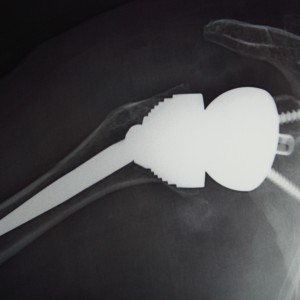There is a small group of patients who have very painful and very stiff shoulders who are told, for a long time and by a lot of specialists, that nothing can be done for their shoulders.
These people are usually elderly but otherwise in a pretty good state of health and are active with their lives being ruined by their useless shoulder.
What they have is a condition called Cuff Tear Arthropathy and, thankfully, I actually have a very good way of dealing with that – the Reverse Geometry Shoulder Replacement.
I’ve read on here about cuff tears and about arthritis so I am guessing that this is a combination of both things?
That’s right. But it is usually a combination of the worst end of the spectrum of both things. So the rotator cuff has rubbed through, the ends have retracted, the muscle has wasted away and the tear is irreparable. So the first half of the problem is loss of function. Even if I put in a normal shoulder replacement you wouldn’t be able to move the arm because you need an intact rotator cuff to move a shoulder. And the arthritis element is usually pretty bad as well. So the only way to get rid of the pain part of the condition is a new shoulder.
How did it happen?
CTA can occur in a number of ways. It can start with arthritis of the gleno-humeral joint and then, later on, the tendons rub through. Or it can be the other way round – so you have a big cuff tear (maybe after a fall and it wasn’t picked up or just with life and use), the shoulder gets out of balance and then arthritis kicks in. Occasionally both can happen together and that is often for a systemic cause rather than a mechanical one.
I have a big swollen shoulder: it’s not that painful but I can’t move it. Is that CTA?
Almost certainly. It’s actually called Senile Haemorrhagic Shoulder which is posh-medical speak for Bloody Old Shoulder! This is the situation where the arthrits and the cuff degeneration occur at the same time and the shoulder is very inflammed and can bleed quite a lot causing swelling. It is worth draining out the blood and fuid because it can make life a bit more comfortable while you think about a shoulder replacement.
But if you can’t fix the tendon, which I need to move the shoulder, what is the point of doing a shoulder replacement?
The standard ‘normal’ geometry (or anatomical) shoulder replacement will help reduce the pain quite a lot. But for most people that’s not enough and they want a useful shoulder not just one that doesn’t hurt.
And that’s where a ‘reverse’ replacement works.
Tell me how? This rotator cuff seems to be so important and you’ve said you can’t fix it.
You actually need more than just the rotator cuff to move the shoulder. Its job is to tighten up and hold the ball centrally on the socket and then it’s the bigger muscles on the outside (including the deltoid) that actually do the donkey work. But the deltoid by itself can’t move a normal shoulder because when it tenses up to try and move the arm, the ball gets pulled upwards on the socket and the deltoid can’t get properly tightened up. It needs the rotator cuff.
Or some other way of keeping the ball central on the socket.
And that’s what a ‘reverse’ geometry shoulder replacement does.
What happens is that I put a new ball where the socket was and a new socket where the ball was (reverse geometry) and this swapped orientation and the shape of the components takes over the job of the rotator cuff and keeps the ball on the socket. So, when the deltoid contracts it can tighten up and move the arm because the ball stays where it is meant to be.
What does the operation involve?
It’s technically very similar to a standard shoulder replacement so you will be in hospital for one night (if you are younger and fitter and have help at home) or up to 3 nights if you are a bit older, a bit less fit and are by yourself.
You have a general anaesthetic and the operation takes about an hour. The incision is around 10 cms long and runs down the outside of your shoulder. Unlike a standard shoulder replacement however, there are no important tendons I need to cut through and then reattach – because you don’t have any tendons left. So access to the worn out joint is very easy and I remove the worn out bits and put in the new bits. Into a sling and back to the ward.
Is it the same long rehabilitation as after a normal replacement?
Actually it is usually a lot quicker. You do have to be in a sling for a month but because you don’t have to wait for an important tendon to heal, we can usually get the arm out and moving under its own steam after a week. There is a lot of hard work to do though because the deltoid muscle will have weakened and wasted over the years your shoulder has been stiff and painful and may not be quite up to the job of moving a whole shoulder all by itself without the help of the rotator cuff. But with time and special exercises it will get nice and strong and your shoulder power will come back.
What about driving and exercising?
You can’t drive while you are in the sling and it will be a few more weeks after you are out of it before you are safe and feel confident to drive; so let’s say it’s about 2 months.
You will be getting plenty of exercise doing your rehabilitation so that will keep you busy and swimming (or at least doing the exercises in the water) is good thing to do. This shoulder isn’t really going to allow you to play tennis or do upper body weight training but it will allow you to play bowls and do quite a lot of things.
That all sounds a bit too good to be true. What is the catch?
It can, and usually does, give a very dramatic improvement in what was a very, very bad shoulder. The pain goes and the movement comes back and patients are delighted with that.
But. The movement may not be as good as a traditional shoulder replacement, especially trying to get the hand up the back, and it is possible that it may not last as long as a traditional shoulder. However as the average age of someone having a reverse shoulder is over 80 and we know they will last 15 years or so then you should be all right on that score.
I do have to be careful about doing it in younger people and I have done them, with great success, in patients in their 50’s when there was no other option. And, so far so good.
I don’t have the arthritis but I do have a massive and irreparable cuff tear with a pretty hopeless shoulder – I can’t even lift my arm up. Would a reverse help me?
Yes it would indeed. The other main reason for using a reverse geometry shoulder is for what you’ve got – a massive tear that can’t be fixed and an arm that can’t be used!
That group of patients is often about 10 years younger than the cuff tear arthritis ones and, again, it is a great way of giving you back a functioning arm.
If you have a very stiff and very painful shoulder, don’t be fobbed off by being told you have a Frozen Shoulder because you probably haven’t and insist on an x-ray. If you are then being told nothing can be done about it insist on seeing a shoulder specialist and check that they do reverse geometry shoulder replacements because there is a good way of making you a lot, lot better.


